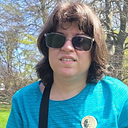Some Thoughts on Disability and Fairy Tales
Content/trigger warnings: discussion of ableism & racism; one link marked as discussing child abuse
Back in February 2019, Amanda Leduc interviewed me (as part of a diverse group of disabled people) as part of her research for her book Disfigured: On Fairy Tales, Disability, and Making Space.
It was fun, and I really appreciate that she quoted and cited me so much in her book. I wrote about it here on my blog in February.
I wanted to wait until after I’d read Amanda’s book before posting this. For a nonfiction book like Disfigured, authors do a lot of research that doesn’t necessarily make it into the finished book. So, I wanted to collect some of my reflections that didn’t end up in the book below.
In fairy tales, I love beautiful language and the feeling of nostalgia. The flip-side of these are clichés and predictability. Characters are often one-dimensional in fairy tales, much less developed than in other forms of literature. Even within an old formula, there’s potential for originality and beautiful world-building. There’s often a simplistic, all-or-nothing, us-and-them view of morality.
When I was a little kid in the ’90s, there were some great feminist retellings of “Cinderella,” like Gail Carson Levine’s novel Ella Enchanted (nothing like the movie) and the movie Ever After. They challenge the oversimplified idea that girls lack agency in fairy tales. I also love The Princess Bride and Shrek because they function on multiple levels for kids and adults. They’re simultaneously homages to — and parodies of — fairy tales. The musical Into the Woods incorporates several fairy tales but returns them to their origins in an almost Freudian way. People who think fairy tales are unsophisticated probably haven’t revisited them since childhood.
I understand the feminist criticism that fairy tales indoctrinate children into traditional relationship and gender roles. This perspective doesn’t really take children’s development into account. When the princesses met princes in the stories, I didn’t think that meant finding a husband was my primary goal in life. I’m an only child, so I was like, “Oh good, she has a friend now!” Any child can have a fairy tale phase before they understand gender, sex, or romance, and it can inspire a love of literature.
I also understand the critiques of Disney, but I’ll always be sentimentally attached to those movies! They were such a huge part of my development. I love musicals and used to do musical theater, so the songs are important memories, too.
The original versions of fairy tales would seem inappropriate for young children today, so I think the sanitized, Disney versions have a purpose. Years later, we can return to them out of nostalgia or seek out the originals. They’re a gateway to literature.
Fairy tales are often cautionary or morality tales for young children, who are just developing their abstract thinking skills. So, it makes sense that they’d use a lot of symbolism. Many fairy tales have a moral of “Don’t judge a book by its cover.” For example, the evil Queen in “Snow White” and Cinderella’s stepsisters are beautiful externally but ugly on the inside, while Cinderella is beautiful inside and out. When the evil Queen transforms into a crone, it’s almost as if that symbolizes her true nature, undermining the “Don’t judge appearances” moral.
“Don’t judge by appearances” is a good lesson, but it’s unfortunate that fairy tales draw a connection between beauty and virtue in the first place. Despite the exceptions to the rule, they still create an association between beauty and good behavior that children wouldn’t have had otherwise. The ableism in fairy tales is also a holdover from the times in which they were told and written, and we still don’t examine that enough.
Being used as a symbol in fairy tales can be very Othering and objectifying. It sends a clear “us and them” message. Whether we’re born disabled or become disabled at any time, including in old age, we’re the Other. We’re not presumed to be the story’s audience.
The word “fair” has multiple meanings in Elizabethan English. There’s the modern definition of equitable and just, but also beautiful and light-complexioned. These multiple connotations persist in Grimm’s fairy tales centuries later (“the fairest of them all”). So, European fairy tales symbolically conflate beauty, youth, able-bodied-ness, whiteness, and virtue. As I said earlier, in European fairy tales, anyone outside of any of these categories is the Other.
Sometimes, when I revisit books that I used to like, I make disturbing discoveries. I know that I discussed The Uses of Enchantment in my Book Riot article linked near the beginning of this post. Later, I did more research into Bruno Bettelheim and found accusations of child abuse, ableism, and plagiarism. (Trigger warning: ableism and child abuse details in the link). His research also influenced the ableist, misogynistic, etc. myth of the “schizophrenogenic mother.” For these reasons, some people may not want to read Bettelheim anymore.
I recommend Amanda’s book instead. It’s by a disabled author, way more recent, and takes an intersectional look at ableism in fairy tales in particular. For folklorists who were contemporaries of Bettelheim’s, I recommend Iona and Peter Opie.
